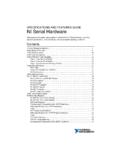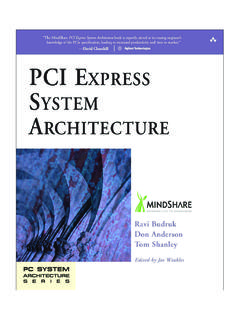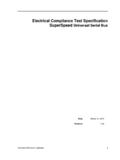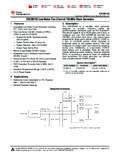Transcription of Xilinx UG393 Spartan-6 FPGA PCB Design Guide
1 Spartan-6 FPGA PCB Design and Pin Planning GuideUG393 ( ) October 17, 2012 Spartan-6 FPGA PCB Design and Pin ( ) October 17, 2012 Xilinx is disclosing this user Guide , manual, release note, and/or specification (the "Documentation") to you solely for use in the development of designs to operate with Xilinx hardware devices. You may not reproduce, distribute, republish, download, display, post, or transmit the Documentation in any form or by any means including, but not limited to, electronic, mechanical, photocopying, recording, or otherwise, without the prior written consent of Xilinx . Xilinx expressly disclaims any liability arising out of your use of the Documentation. Xilinx reserves the right, at its sole discretion, to change the Documentation without notice at any time. Xilinx assumes no obligation to correct any errors contained in the Documentation, or to advise you of any corrections or updates.
2 Xilinx expressly disclaims any liability in connection with technical support or assistance that may be provided to you in connection with the DOCUMENTATION IS DISCLOSED TO YOU AS-IS WITH NO WARRANTY OF ANY KIND. Xilinx MAKES NO OTHER WARRANTIES, WHETHER EXPRESS, IMPLIED, OR STATUTORY, REGARDING THE DOCUMENTATION, INCLUDING ANY WARRANTIES OF MERCHANTABILITY, FITNESS FOR A PARTICULAR PURPOSE, OR NONINFRINGEMENT OF THIRD-PARTY RIGHTS. IN NO EVENT WILL Xilinx BE LIABLE FOR ANY CONSEQUENTIAL, INDIRECT, EXEMPLARY, SPECIAL, OR INCIDENTAL DAMAGES, INCLUDING ANY LOSS OF DATA OR LOST PROFITS, ARISING FROM YOUR USE OF THE DOCUMENTATION. 2009 2012 Xilinx , Inc. Xilinx , the Xilinx logo, Virtex, spartan , ISE, Vivado, Artix, Kintex, Zynq and other designated brands included herein are trademarks of Xilinx in the United States and other countries.
3 All other trademarks are the property of their respective HistoryThe following table shows the revision history for this document. DateVersionRevision09/21 Xilinx Guide title and added Chapter 6 and Appendix A. Replaced Ta b l e 2 - values in Ta b l e 2 - 1 and added note 3. Added HSWAPEN and VREF Pins in Chapter 6. 10/17 the Readback CRC section. Added I/O and VREF Pins section and notes to the Memory Controller Block and PCI sections. Updated the unused GTP transceiver connections description in the GTP Transceiver Pin Planning Considerations section. Updated BUFIO2 I/O Clock Buffer Usage FPGA PCB Design and Pin ( ) October 17, 2012 Revision History .. 2 Preface: About This GuideGuide Contents .. 7 Additional Documentation.. 7 Additional Support Resources.. 8 Chapter 1: PCB Technology BasicsPCB Structures.
4 9 Traces .. 9 Planes .. 9 Vias .. 10 Pads and Antipads .. 10 Lands .. 10 Dimensions .. 10 Transmission Lines .. 11 Return Currents.. 12 Chapter 2: Power Distribution SystemPCB Decoupling Capacitors .. 13 Recommended Capacitors per Device .. 13 Required PCB Capacitor Quantities .. 14 Capacitor Specifications .. 16 PCB Bulk Capacitors.. 16 PCB High-Frequency Capacitors .. 16 Capacitor Consolidation Rules .. 17 PCB Capacitor Placement and Mounting Techniques .. 17 PCB Bulk Capacitors.. 170805 Ceramic Capacitor .. 180402 Ceramic Capacitor .. 19 Basic PDS Principles .. 20 Noise Limits .. 20 Role of Inductance .. 22 Capacitor Parasitic Inductance .. 22 PCB Current Path Inductance .. 24 Capacitor Mounting Inductance.. 24 Plane Inductance .. 25 FPGA Mounting Inductance.
5 26 PCB Stackup and Layer Order .. 27 Capacitor Effective Frequency .. 28 Capacitor Anti-Resonance .. 30 Capacitor Placement Background .. 30 VREF Stabilization Capacitors .. 31 Power Supply Consolidation .. 31 Unconnected VCCO Pins .. 32 Table of FPGA PCB Design and Pin PlanningUG393 ( ) October 17, 2012 Simulation Methods .. 32 PDS Measurements .. 33 Noise Magnitude Measurement .. 33 Noise Spectrum Measurements .. 35 Optimum Decoupling Network Design .. 37 Troubleshooting .. 37 Possibility 1: Excessive Noise from Other Devices on the PCB .. 37 Possibility 2: Parasitic Inductance of Planes, Vias, or Connecting Traces .. 37 Possibility 3: I/O Signals in PCB are Stronger Than Necessary .. 38 Possibility 4: I/O Signal Return Current Traveling in Sub-Optimal Paths .. 38 Chapter 3: SelectIO SignalingInterface Types.
6 39 Single-Ended versus Differential Interfaces .. 39 SDR versus DDR Interfaces .. 40 Single-Ended Signaling .. 40 Modes and Attributes .. 40 Input Thresholds .. 40 Chapter 4: PCB Materials and TracesHow Fast is Fast?.. 41 Dielectric Losses .. 41 Relative Permittivity .. 41 Loss Tangent .. 42 Skin Effect and Resistive Losses .. 42 Choosing the Substrate Material .. 42 Traces.. 43 Trace Geometry .. 43 Trace Characteristic Impedance Design for High-Speed Transceivers .. 43 Trace Routing .. 45 Plane Splits .. 45 Return Currents .. 45 Simulating Lossy Transmission Lines .. 46 Cable .. 46 Connectors .. 46 Skew Between Conductors .. 46 Chapter 5: Design of Transitions for High-Speed SignalsExcess Capacitance and Inductance.. 47 Time Domain Reflectometry .. 47 BGA Package.
7 49 SMT Pads.. 49 Differential Vias .. 53P/N Crossover Vias.. 56 SMA Connectors.. 56 Backplane Connectors.. 56 Microstrip/Stripline Bends .. 56 Spartan-6 FPGA PCB Design and Pin ( ) October 17, 2012 Chapter 6: I/O Pin and Clock PlanningConfiguration and Other Multi-Function Pins .. 61 Configuration Pin Planning Considerations .. 61 Multi-function Configuration.. 61 Configuration Options .. 62I/O and VREF Pins .. 62 HSWAPEN and VREF Pins .. 62 Memory Controller Block .. 63 MCB Pin Planning Considerations.. 63 MCB Clocking Considerations .. 64 PCI .. 64 GTP Transceivers .. 64 GTP Transceiver Pin Planning Considerations .. 64 GTP Transceiver Clocking Considerations .. 65 PCI Express .. 65 Other GTP Transceiver Based Tools .. 65 Global and I/O Clocking .. 65 GCLK Pin Assignment.
8 65 BUFIO2 I/O Clock Buffer Usage .. 66 Overview of BUFIO2 Resource Usage per Interface Type .. 67 Bidirectional I/O.. 67 Serializing Interfaces.. 67 Pin Planning Considerations .. 67 Single-Ended SerDes.. 67 Differential SerDes .. 68 Power Management Using Suspend/Awake.. 68I/O Standards and I/O Banking Rules .. 68 Simultaneous Switching Output (SSO) Management .. 68 Running Design Rule Checks .. 68 Density Migration .. 69 Appendix A: Recommended PCB Design RulesRecommended PCB Design Rules for QFP Packages.. 71 Recommended PCB Design Rules for BGA and CSP Packages .. FPGA PCB Design and Pin PlanningUG393 ( ) October 17, 2012 Spartan-6 FPGA PCB Design and Pin ( ) October 17, 2012 PrefaceAbout This GuideThis Guide provides information on PCB Design for spartan -6 devices, with a focus on strategies for making Design decisions at the PCB and interface level.
9 Guide ContentsThis Guide contains the following chapters: Chapter 1, PCB Technology Basics, discusses the basics of current PCB technology focusing on physical structures and common assumptions. Chapter 2, Power Distribution System, covers the power distribution system for Spartan-6 fpgas , including all details of decoupling capacitor selection, use of voltage regulators and PCB geometries, simulation and measurement. Chapter 3, SelectIO Signaling, contains information on the choice of SelectIO standards, I/O topographies, and termination strategies as well as information on simulation and measurement techniques. Chapter 4, PCB Materials and Traces, provides some guidelines on managing signal attenuation to obtain optimal performance for high-frequency applications. Chapter 5, Design of Transitions for High-Speed Signals, addresses the interface at either end of a transmission line.
10 The provided analyses and examples can greatly accelerate the specific DocumentationThe following documents are also available for downloaded at Spartan-6 Family OverviewThis overview outlines the features and product selection of the Spartan-6 family. Spartan-6 FPGA Data Sheet: DC and Switching CharacteristicsThis data sheet contains the DC and switching characteristic specifications for the Spartan-6 family. Spartan-6 FPGA Packaging and Pinout SpecificationsThis specification includes the tables for device/package combinations and maximum I/Os, pin definitions, pinout tables, pinout diagrams, mechanical drawings, and thermal specifications. Spartan-6 FPGA Configuration User FPGA PCB Design and Pin PlanningUG393 ( ) October 17, 2012 Preface:About This GuideThis all-encompassing configuration Guide includes chapters on configuration interfaces (serial and parallel), multi-bitstream management, bitstream encryption, boundary-scan and JTAG configuration, and reconfiguration techniques.















